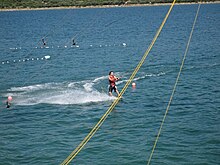Water ski lift

A water ski lift or water ski cable car is a system on a body of water that can be used for water skiing or wakeboarding . The term is derived from that of the ski lift and works in a technically similar way. In contrast to this, the aim of a water ski lift is not to gain height, but to move the person pulled horizontally across the surface of the water at the speed required for water skiing.
history
The water ski ropeway was invented by Bruno Rixen in the early 1960s and made ready for the market. His inventions include the start at right angles to the circulating rope, whereby the starting runner is gently accelerated without reducing the speed of the circulating rope, as well as the double circulating rope. This is the only way to meet the requirements of water skiing, such as high speed and high lateral forces in slalom running. The first commercially operated water ski cableway was built in the Mediterranean off Benidorm in Spain in 1966 . Today there are around 363 water ski and wakeboard cable cars worldwide, including 112 two-mast systems in 48 countries.
technology
A water ski lift is usually set up in the form of a closed circuit. An electric motor drives two endless, parallel, one above the other, about 350 to 1000 meter long wire rope loops , which run horizontally over the water in a four-, five- or hexagonal course about eight to nine meters above the water surface. At the corner points there are supports that carry double pulleys to deflect the hoisting ropes. The distance between the two pulleys on the bearing axles also determines the distance between the ropes. The supports are braced towards the banks, inclined tubular tubular structures with cantilevers that hang into the course from the outside to ensure sufficient space for water sports enthusiasts passing under the supports. The support closest to the starting point usually carries the drive motor.
The two parallel circulating rope loops are firmly connected approximately every 80 meters with a driver that is clamped to both ropes and on which the pulling lines are ultimately attached. The water sports enthusiast holds on to these pull lines, at the end of which there is a handle. The water skiers start from a ramp while standing or sitting and are gradually accelerated to the speed of the circulating rope.
The speed of the circulating rope of such a system can be continuously adjusted up to 61 km / h. The speed is set depending on the sports equipment being driven. With a wakeboard, a speed above 40 km / h is hardly possible, with a mono water ski, however, 58 km / h are possible. The runners can reach speeds of over 120 km / h through slalom rides.
criticism
The operation of water ski lifts is not always undisputed. Local fishing clubs fear that such systems will cause too much movement into the water and frighten fish. However, there are studies that show an increase in water quality due to an increased oxygen content.
Web links
- Locations at the International Cableways Association
- Worldwide locations of all IWWF water ski ropeways
- Overview of water ski lifts in Germany, Austria and other countries
- Overview of water ski ropeways in Germany
Individual evidence
- ↑ History and development of the water ski ropeway ( Memento of the original from September 17, 2012 in the Internet Archive ) Info: The archive link has been inserted automatically and has not yet been checked. Please check the original and archive link according to the instructions and then remove this notice. , cablewakeparks.us, accessed on March 25, 2012 (English)
- ^ The revolutionary idea of Bruno Rixen , Münchner Merkur, July 5, 2011
- ^ Rhein Main Presse Accessed on March 24, 2012.
- ↑ Unadulterated bathing fun RP.online, May 24, 2009, accessed on December 25, 2014.

